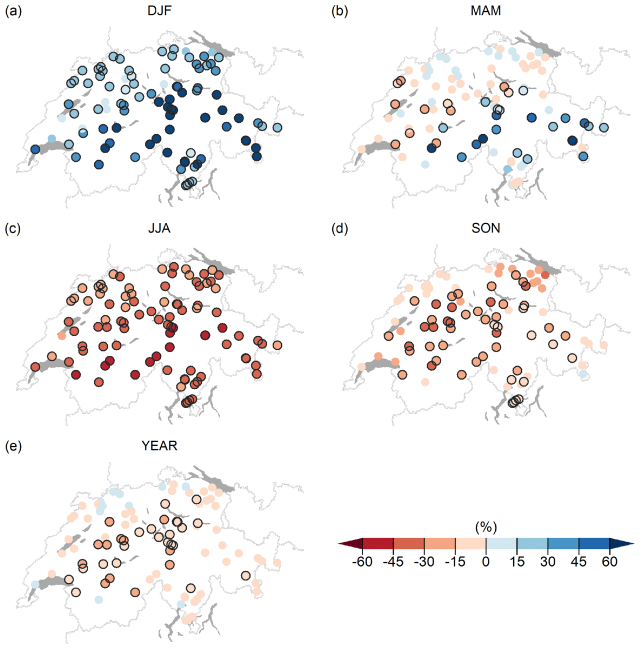Runoff from the Swiss mountains is important for hydropower, but also for water availability in Switzerland and many other downstream countries including The Netherlands. In two recent papers, Muelchi and co-workers investigated runoff under future changes in temperature and precipitation.
Runoff in mountainous areas is highly sensitive to temperature, precipitation, as well as the combination between the two, mainly due to the clear temperature thresholds involved in snowfall and snowmelt. This is why future projections of runoff need to take into account the best available information on changes in atmospheric forcing. In two recent studies, Muelchi and co-workers analyzed future changes in runoff for 93 medium-sized catchments in Switzerland based on the latest Swiss Climate Change Scenarios CH2018. The CH2018 scenarios use EURO-CORDEX simulations and apply statistical downscaling on chains of global circulation models and regional climate models.

In their studies, Muelchi et al. found a divergent pattern in streamflow changes. In winter, most basins show a runoff increase, with the strongest increase in the high Alps. In spring, the lower parts of Switzerland will see a streamflow decrease, while increases are projected for the higher parts (see figure). In summer, the pattern is reversed, and widespread streamflow decrease is projected, with the strongest decreases in the higher parts, Over a whole year, most basins show a slight decrease in runoff. In the second part of their study, Muelchi et al. (2021b) also investigated the changes in low flows and hydrological drought. In line with the seasonal changes, they found strong increases in the occurrence of projected summer low flows, with low flows expected to decrease by as much as 50% in many basins.
The results from the two papers are generally in line with results from another recent study by Joost Buitink, who evaluated how recent changes in precipitation and temperature have been affecting discharge in the whole Rhine basin. In that study, it was shown that temperature effects alone lead to a clear overall reduction in Rhine discharge, with reductions exceeding 10% already for moderate degrees of warming. But these results are likely model-dependent. In a 2018 study analyzing simulated trends in mean streamflow for 605 basins in the U.S., Lieke Melsen found that even the sign of the trends was subject to the choice of forcing (i.e. which GCM), the way the model was calibrated, and model structure. In particular in regions where snow processes or other strongly nonlinear (threshold) processes dominate seasonal water availability, robust projections remain challenging.
Further reading
Buitink, J.; L. A. Melsen & A. J. Teuling (2021), Seasonal discharge response to temperature-driven
changes in evaporation and snow processes in the Rhine basin. Earth System Dynamics,
12, 387–400, doi:10.5194/esd-12-387-2021.
Melsen, L. A.; N. Addor; N. Mizukami; A. J. Newman; P. J. J. F. Torfs; M. P. Clark; R. Uijlenhoet &
A. J. Teuling (2018), Mapping (dis)agreement in hydrologic projections. Hydrology and Earth
System Sciences, 22, 1775–1791, doi:10.5194/hess-22-1775-2018.
Muelchi, R.; O. Rössler; J. Schwanbeck; R. Weingartner & O. Martius (2021a), River runoff in Switzerland in a changing climate – runoff regime changes and their time of emergence. Hydrol. Earth Syst. Sci., 25, 3071–3086, https://doi.org/10.5194/hess-25-3071-2021, 2021
Muelchi, R.; O. Rössler; J. Schwanbeck; R. Weingartner & O. Martius (2021b), River runoff in Switzerland in a changing climate – changes in moderate extremes and their seasonality. Hydrol. Earth Syst. Sci., 25, 3577–3594, https://doi.org/10.5194/hess-25-3577-2021.

